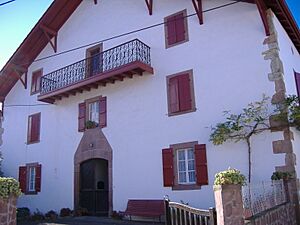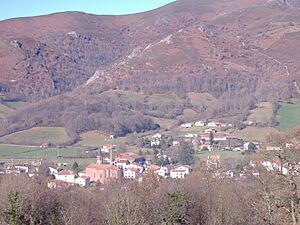Ossès facts for kids
Quick facts for kids
Ossès
|
||
|---|---|---|

Road to Ossès
|
||
|
||
| Country | France | |
| Region | Nouvelle-Aquitaine | |
| Department | Pyrénées-Atlantiques | |
| Arrondissement | Bayonne | |
| Canton | Montagne Basque | |
| Intercommunality | CA Pays Basque | |
| Area
1
|
42 km2 (16 sq mi) | |
| Population
(Jan. 2021)
|
Lua error in Module:Wd at line 1,575: attempt to index field 'wikibase' (a nil value). | |
| Time zone | UTC+01:00 (CET) | |
| • Summer (DST) | UTC+02:00 (CEST) | |
| INSEE/Postal code |
64436 /64780
|
|
| Elevation | 101–892 m (331–2,927 ft) (avg. 282 m or 925 ft) |
|
| 1 French Land Register data, which excludes lakes, ponds, glaciers > 1 km2 (0.386 sq mi or 247 acres) and river estuaries. | ||
Ossès (Basque: Ortzaize) is a small and charming village in the south-west of France. It is located in the Pyrénées-Atlantiques department. This region is part of the traditional Basque Country, known for its unique culture and language. Ossès is also called Ortzaize in the Basque language.
Contents
Discovering Ossès Geography
Ossès is nestled in the foothills of the Pyrenees mountains. It is about 13 kilometers (8 miles) north-west of Saint-Jean-Pied-de-Port. The village sits in the beautiful Ossès valley, which is part of the valley of the river Nive. This area is famous for the pottok, a special wild Basque horse.
The countryside around Ossès is very beautiful. You can find many trails for walking and great spots for picnics. A local poet once said the air here felt like it came "straight from heaven"!
Nearby Villages and Towns
Ossès is surrounded by several other interesting villages. These include:
A Glimpse into Ossès History
The village of Ossès has a long and interesting past. It was once controlled by the Dukes of Gascogne, and then by the Duke of Aquitaine. Later, it became part of the Kingdom of Navarre. This happened in 1191 when Princess Berengaria of Navarre married Richard the Lionheart, a famous English king. Berengaria was the daughter of King Sancho the Wise of Navarre.
Ossès used to be an important administrative area called a canton. However, it lost this status after the French Revolution. The French Revolution was a big event in France's history that changed many things about how the country was governed.
Exploring Ossès Sights
Ossès has many interesting places to see. The village is home to a beautiful church from the 16th century called St-Julien. This church is special because it has a unique seven-sided tower. Inside, you can see a famous altarpiece, which is a decorated screen behind the altar. One of the church's walls is also a fronton, which is a court used for Basque pelota, a traditional Basque sport.
The graveyard near the church has a few stone Basque crosses. These crosses are a common sight in the Basque Country and have a unique design.
Around the village square, you can find several traditional Basque houses. These houses are easy to spot with their pink sandstone lintels (the stone above a doorway) and half-timbers (wooden frames with the spaces filled in). One famous house is the Maison Sastriarena, built in 1628. Important people, like the Bishops of Bayonne, were often hosted here. Another historic house is the Maison Harizmendi. In 1660, the religious leader who married King Louis XIV and Maria Theresa stayed here on his way to their wedding celebration. The old laundry building in the village has also been carefully kept.
Ossès Local Economy
The area around Ossès is known for producing some delicious local goods. Two famous products are Irouléguy wine and Ossau-Iraty cheese. These are made from local ingredients and traditions.
Besides food and drink, tourism is very important to the local economy. Many visitors come to enjoy the beautiful scenery and learn about Basque culture. Local crafts and agriculture also play a big part in supporting the people who live in Ossès.
Getting Around Ossès: Transport
Ossès has a railway station called Ossès-Saint-Martin-d'Arrossa. This station is on the railway line that connects Bayonne and Saint-Jean-Pied-de-Port. Several trains run each day, making it easy to travel to and from the village. The station is only about 1 kilometer (0.6 miles) from the center of Ossès. There is also a bus service that connects to Saint-Étienne-de-Baïgorry, which lines up with the train schedule.
Ossès Village Festival
The village of Ossès holds a special festival every year. It takes place on the last Sunday in August. This is a time for everyone to celebrate with music, food, and fun activities.
See also
 In Spanish: Ossès para niños
In Spanish: Ossès para niños







